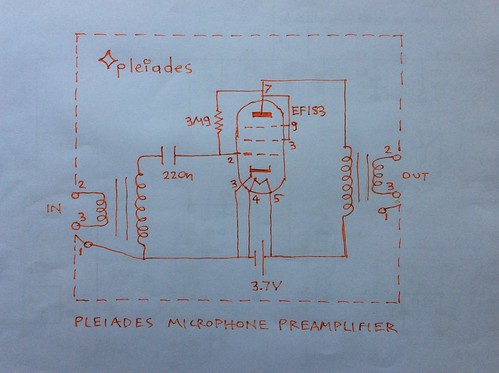Referring for example to the (open source) Pleiades V6 circuit:

Varying the anode to grid bias resistor (Pleiades bias) changes the sound quality.
The lower the Rag or Rp resistor the more the grid potential approaches from negative towards 0 volt potential with respect to cathode. The higher the anode current. The lower the electron tube anode (output) resistance. The lower the grid input impedance. The bandwidth of the whole system changes as the input and output transformers interact with there changes. A new electron tube operating point is created. Different overload characteristics are archived, different output transformer (magnetic core operating point shifting towards magnetic saturation) overload characteristics etc.
The sound character change effect was most clearly observed with a 7586 Nuvistor electron tube operating in this circuit. See yesterday's posts. Alternatively 6MΩ and 2MΩ biasing resistors were used.
Some background information...These circuits are designed to operate with minimum anode voltage so that the same battery can supply both heaters and anode circuit. This results in great simplification, no need of bulky AC power supply, no power supply induced noise, minimum tube noise, maximum noise figure, due to low anode voltage or tube temperature therefore almost complete absence of electron secondary emission effects etc.
Notwithstanding the above my dad always insists that batteries are much safer than mains.
The concept behind using a positive voltage source for bias to free electrons comes from Hliana. Here is how it works...If nothing is connected to the grid and the heater voltage is applied, as soon as the cathode emits electrons the control grid is increasingly becoming negative with respect to cathode. The cathode is missing electrons ie becomes positive. A typical steady state value of grid to cathode potential when 5V are applied to heaters is -700mV. See previous posts.
This strong retarding electric field prohibits any electrons arriving to the anode when low anode voltage is used.
When a high Megohm resistor is returned from grid to cathode (which is positive by 700mV) the grid becomes less negative. Some anode current exists. The electron tube operates but still not satisfactorily at a low anode voltage of the order of 6V.
When the grid resistor is returned to the anode the higher pull up voltage further increases the grid bias to a typical value of -100mV to -50mV. Tye value a truly also depends on cathode temperature adjusted by varying the heater voltage to lower values.
The anode current becomes many magnitudes greater. Typical values are from 50μA to more than 100μA at a typical anode voltage of 4V.
At such conditions the electron tube operates with high gain, transconductance, exceptional low noise. Great sound. Revealling the subtlest detail of moving coil microphone for example.
If the Pleiades or anode bias is further increased by a lower Pleiadss or anode to grid bias resistor the anode current further increases. The sound changes.
The difference between a low anode current to higher can be described as from a more full Motown type vocal sound to a more modern Moton vocal such as Endless Love - Lionel Richie, Dianna Ross. The high frequencies become more crisp at the expense of less full bodied sound.
In between sound quality can be programmed by changing the anode to grid resistor. It may be possible to make quick changes with a switch array even while listening to the amplifier circuit. The high value of resistors involved seem to avoid creating large thump sound.
The output of this circuit is a low noise high output mic level signal to be connected to a microphone preamplifier in the same way as the strong, low noise output of a Neumann U47 microphone would be connected to the rest of the signal path chain.
References:
On preserving electron tube transconductance at anode potential as low as 3V - euroelectron
Operating features of the Audion - E. H. Armstrong
No comments:
Post a Comment